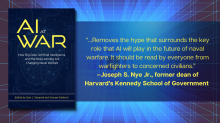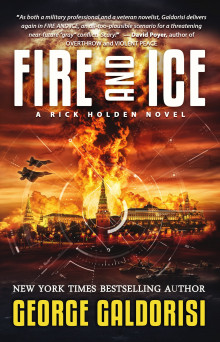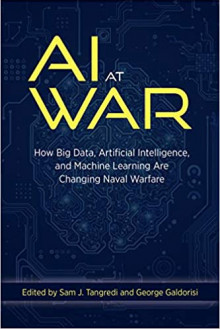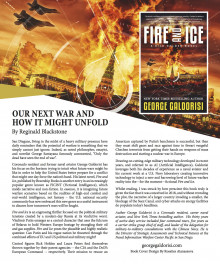Joseph S. Nye Jr. Review of AI at WAR


Many commentators have accused the U.S. military of “preparing for the last war.” While there may be some truth to this criticism, there is a movement afoot to better prepare for the wars of tomorrow.
Throughout the 20th Century, planning for tomorrow’s conflicts occurred almost exclusively within the walls of the Pentagon. With a known adversary – first the Soviet Union and then the threat of worldwide terrorism – this was an acceptable strategy. However, today, with substantially more-nuanced threats to the United States, this is no longer the case.
For years, a number of writers have envisioned future warfare and have expressed those ideas in novels and shorter works. Those U.S. officials responsible for the security and prosperity of America either disregarded these stories or criticized them as unhelpful to crafting a coherent national and military strategy.
This has changed in the 21st Century with a new genre of military-themed works of fiction. Labeled FICINT – generally understood to be imagining future warfare scenarios based on the realities of high-end combat and real-world intelligence, not fantasy – the U.S. national security community has now embraced this new genre as a useful instrument to intuit how tomorrow’s wars will be fought.
As one indication of how FICINT is having an impact, a number of U.S. military commands and think tanks focused on military matters such as The U.S Army Training and Doctrine Command, the Marine Corps Warfighting Laboratory, the Joint Artificial Intelligence Center, the U.S. Naval War College, the U.S. Army War College, the Atlantic Council, the Center for International Maritime Security, the U.S. Naval Institute, and others, now sponsor fiction writing contests to tease out good ideas from FICINT writers.
There is a sea change in the way that the U.S. national security community, and especially the U.S. military, are embracing these changes. There have been several recent FICINT novels, Fire and Ice among them, as well as other works – many written by active or retired military officers – that are helping the U.S. plan for tomorrow’s wars, not yesterday’s.
Here is what one defense analyst had to say about Fire and Ice

Few writers are as successful as Francine Prose (and what a great name for a writer!) and few likely work harder at their craft (Prose typically does dozens of drafts of each novel).
Most of us who write would like to be as successful as Francine Prose. That is why I was drawn to a piece about her with the intriguing title of: “‘I’m Easily Bored by Books,’ Says Writer of 22 Novels.” Here is how it begins:
Francine Prose writes a lot.
During her nearly 50-year career, Prose has published 30 books along with reams of essays, reviews, columns and travelogues on subjects as diverse as Anne Frank, Peggy Guggenheim, Caravaggio and bacon. And while her work deals in weighty themes like truth, identity and power, even when she’s writing about breakfast foods, she is not precious about it.
“I hate the word process, I just can’t bear it,” Prose said in an interview. “People say, ‘What’s your process?’ My process is allowing my soul to leave my body and enter into the body of another human being. So try that!”
Her latest novel, “The Vixen,” which will be published on Tuesday by Harper, is a good example. It is about Ethel and Julius Rosenberg, the C.I.A. and book publishing. And it is often hilarious.
“We have to entertain ourselves somehow,” she said.
Want more? You can read the rest of the piece here

Originally From: The Greater Los Angles Writer’s Society
Fire and Ice is a thriller focused on the political-military tensions created by a modern-day Russia at its vindictive worst. Vladimir Putin emerges as the central character who uses the fulcrum of Belarus to threaten western Europe through a series of lethal and effective attacks on US and European energy sources. Fire and Ice poses the plausible and highly realistic question: Can Putin and his rogue nation be thwarted through the combined efforts of EU and US and political and military might?
Rick Holden and Laura Peters, reunited after several years of being assigned to commands half a world apart, find themselves thrown together by their parent agencies—the CIA and the DoD’s European Command, respectively. Their mission to rescue a captured American is successful, but then they must turn on a dime and race against time to thwart the transfer of weapons of mass destruction to vengeful terrorists.
Fire and Ice is a new entry in the increasingly popular genre commonly known as “FICINT”—imaging future warfare scenarios based on the realities of high-end combat and real-world intelligence, not fantasy. It leaves the reader wondering not if, but when, such a cataclysmic scenario might play out in our lifetimes. Drawing on the cutting-edge military technology he discusses in his recent non-fiction work: AI at War: How Big Data, Artificial Intelligence and Machine Learning Are Changing Naval Warfare, George Galdorisi injects a new level of future warfare reality into Fire and Ice.
 George Galdorisi is a career naval aviator and writer, specializing in “FICINT,” combining fiction writing with current intelligence to envision future warfare. He began this journey almost a decade ago with the New York Times best seller, Tom Clancy Presents: Act of Valor (Penguin), the novelization of the Relativity Media number-one rated movie. This was followed in rapid succession by three more New York Times best sellers in the rebooted Tom Clancy’s Op-Center series: Out of the Ashes, Into the Fire, and Scorched Earth (St. Martins). Continuing in the FICINT tradition, his three most recent thrillers are The Coronado Conspiracy, For Duty and Honor and the just-released (March 2021) Fire and Ice (Braveship Books).
George Galdorisi is a career naval aviator and writer, specializing in “FICINT,” combining fiction writing with current intelligence to envision future warfare. He began this journey almost a decade ago with the New York Times best seller, Tom Clancy Presents: Act of Valor (Penguin), the novelization of the Relativity Media number-one rated movie. This was followed in rapid succession by three more New York Times best sellers in the rebooted Tom Clancy’s Op-Center series: Out of the Ashes, Into the Fire, and Scorched Earth (St. Martins). Continuing in the FICINT tradition, his three most recent thrillers are The Coronado Conspiracy, For Duty and Honor and the just-released (March 2021) Fire and Ice (Braveship Books).
His FININT work—imaging future warfare scenarios based on the realities of high-end combat and real-world intelligence, not fantasy—is supported by his thirty years as a naval aviator, including four command tours and five years as a carrier strike group chief of staff, culminating in two combat tours in the Arabian Gulf. During this final tour he also led the U.S. delegation for military-to-military talks with China’s People’s Liberation Army, Navy. Adding to his ability to harness all-source, open-source, intelligence to support these FICINT efforts, he is currently the Director of Strategic Assessments and Technical Futures at the Navy Information Warfare Center Pacific in San Diego, California.
Other than writing thrillers, George likes nothing more than connecting with readers. You can follow him on Facebook and Twitter, and learn more about his books, blogs and other writing on his website: http://georgegaldorisi.com/—especially his “Writing Tips,”—which offer useful advice for all writers from established authors to future best-selling writers.
In this episode I have the honor of sitting down with one of my mentors, Navy Captain George Galdorisi. George is a Leader, Mentor, Strategic Thinker, National Security expert, and author of 15 books. George discusses his latest Rick Holden thriller, Fire and Ice. It is fiction that experts claim helps to strategize the challenges Russia presents in the real world today.
Many writers write novels about warfare. Some of them write about the future of warfare. Sadly, most base what they write about on fantastical, made up scenarios that bear no connection with reality. Jeff Edwards is not one of them, His latest thriller follows a long line of riveting, and convincing military thrillers and are informed by his decades of service as U.S. Navy professional. The Damocles Agends is a book you won’t want to miss.

05/31/2021
Recently, USNI press has published a book edited by Sam J. Tangredi and George Galdorisi entitled AI at War: How Big Data, Artifical Intellignece and Machine Learning are Changing Naval Warfare.
The book provides a useful overview to various perspectives on how AI and autonomous systems might shape the way ahead with regard to the evolution of warfare.
I would suggest the might shape point.
In effect, the art of warfare is changing under the impact of several forces for change, not simply how data is managed or how machines might operate as force extenders for manned platforms.
In reality, the book really focuses on command and control, and many of the chapters focus on that subject.
The shift from the land wars back to peer competitor warfare is built around the return of mission command and C2 as the heart of shaping the way ahead for distributed forces.
The standup of Second Fleet in Norfolk and the associated commands under VADM Lewis’s leadership are being crafted into a warfighting force around mission command and distributed C2 and reworking task force concepts.
Autonomous systems and better information management will enhance the lethality, survivability and capability of such a force, but that is the mid-term.
But without working the core concept of operations shifts, adding new machines will not have the impact they might have.
A good way to look at this dynamic is provided in the chapter by Harrison Schramm and Bryan Clark.
“A more disaggregated and reconfigurable force structure would enable a wider variety of potential force presentations. An AI-enabled control system could exploit the composability of a disaggregated force to create greater adaptability for the U.S. military and impose more dilemmas and complexity on an adversary, thereby increasing the opponent’s uncertainty.”
In my work with the Australian Defence Force and the recent Williams Foundation Seminar on Next Generation Autonomous Systems this is a key focus of attention for the ADF.
Reshaping the maritime force to operate as a fleet, and to do so in terms of blue water expeditionary operations is the foundation from which a transition to use effectively autonomous systems within which AI would play a decision guidance role is foundational.
There are several thoughtful chapters on C2 as the U.S. Navy turns its focus to peer warfare.
But as it does so there are three very important considerations which affect big data, AI and its use.
The first is that the peer competitors we are talking about are nuclear powers, so that any consideration of how to manage attacks upon peer adversaries must consider how those attacks affect the calculations of adversaries.
The second is that understanding of how adversaries think and how they might act is part of the calculation which AI processing of data can assist if we indeed have the knowledge to know what we are looking for and what we are looking at.
This is a huge gap as we turn from being Middle East experts to calibrating how authoritarian leaders in Russia and China under the global stress of COVID-19 and the post-globalization era looks like and how best to use military tool sets?
The third is the question of targeting.
There is a good treatment of the targeting or fires solution problem by Michael O’Gara.
He provides a cautious and careful assessment of how AI can help in the decision process to make a fires solution.
As he notes: “AI holds promise in handling resource priorities across domains more seamlessly while being capable of initiating responses based on more accurate and timely threat assessments.”
But of course, the core targeting problem is not simply the speed to attack but also target selection in a crisis management setting.
But if confidence in both the speed and accuracy to attack is high and can be assisted by more rapid and effective data management and decision tools, then that can assist in providing for a wider set of crisis management options, from the standpoint of decision-making confidence as well.
The book does consider as well the problem of ability to spoof AI-enabled systems.
But there is as well the potential for distributed fleets to develop packages which they can deploy to deceive the adversary as well, even in terms of effective operating location.
The US Navy’s Nemesis program is suggestive of such a possibility.
And in considering the future, it is important not to ignore the warfighting advantages our force already has that the adversary does not.
For example, the ability of an 8-ship F-35 formation to fight as a wolfpack, suggests what swarming could deliver in the midterm future.
The ability of U.S. and allied F-35s to operate over large areas like the North Atlantic and the Mid-Pacific to shape a COP and target identification has barely been scratched. These are harbingers of things to come, but they are here now.
The future is now.
The mid-term and long-term future are just that and mostly unknowable.
How well did the forecasters in 2019 do in forecasting 2020?
The book provides a very useful collection of essays which frame ways to think about AI, big data and C2 might change the future of warfare. It is well worth reading.
https://www.usni.org/press/books/ai-war
Author’s Note: In a recently published Australian study on AI and the military, Peter Layton provided an interesting look at how to consider different ways AI-enabled assets might play out on future battlefields.
The conclusion to his study provides a very helpful and balanced look at the way ahead with regard to AI and warfare:
In the near-to-medium term, AI’s principal attraction for military forces will be its ability to quickly identify patterns and detect items hidden within very large data troves. AI will make it much easier to detect, localise and identity objects across the battlespace. Hiding will become increasingly difficult.
However, the technology of contemporary AI has inherent problems. It is brittle, in being able to operate only in the context it has been trained for; it is unable to transfer knowledge gained in one task to another and it is dependent on data. Accordingly, AI when used in real-world situations needs to be teamed with humans. The strengths of AI can then counterbalance the weaknesses in human cognition and vice versa….
As a general-purpose technology, AI is becoming all-pervasive and will over time infuse most military equipment. Such ubiquity though means AI is likely to be initially employed within existing operational level thinking. In the short-to-medium term, it will enable the battlefield, not remake it.
In simple terms, AI’s principal warfighting utility can be expressed as ‘find and fool’. With its machine learning, AI is excellent at finding items hidden within a high-clutter background. In this role, AI is better than humans and tremendously faster. On the other hand, AI can be fooled through various means. AI’s great finding capabilities lack robustness.
AI’s ‘find’ abilities further provide mobile systems with a new level of autonomy, as the AI can analyse its surroundings to discern important operating data. This means that ‘find and fool’ tasks can be undertaken using in-motion and at-rest, AI-enabled systems featuring varying levels of autonomy. AI can bring to modern warfighting enhanced sensors, improved kinetic and non-kinetic kill systems, more convincing deception techniques and a wide array of ways to confuse. In this, it is crucial to remember that AI enlivens other technologies. AI is not a stand-alone actor, rather it works in combination with numerous other digital technologies, providing a form of cognition to these.
If being used for defensive tasks, a large number of low-cost IoT sensors using AI edge computing could be emplaced in the optimum land, sea, air, space and cyber locations in a territory in which an attacking force may move across. From these sensors, a deep understanding would be gained of the area’s terrain, sea conditions, physical environment and local virtual milieu. Having this background data accelerates AI’s detection of any movement of hostile military forces across it….
For Layton, the operational shift which AI-enabled warfare entailed could be understood as a shift from the kill chain to the kill web.
The kill chain model used by contemporary military forces tightly integrates the sense–decide–act logic flow. In contrast, the data flow across the large Internet of Things (IoT) field in the mosaic warfare construct creates a kill web, where the best path to achieve a task can be determined and used in near real-time. The use of the IoT field is then fluid and constantly varying, not a fixed data flow as the kill chain model implies. The outcome is that the mosaic warfare concept provides commanders with highly resilient networks of redundant nodes and multiple kill paths. Moreover, the mosaic concept aims to be scalable; the size and elements of the IoT field can be varied as battlefield circumstances demand.

San Diegans, living in the midst of a heavy military presence have daily reminders that the potential of warfare is something that we simply cannot just ignore. Indeed, as noted philosopher, essayist, and novelist George Santayana famously commented, “Only the dead have seen the end of war”.
Coronado resident and former naval aviator George Galdorisi has his focus on the horizon trying to intuit what future wars might be like in order to help the United States better prepare for a conflict that might one day force the nation’s hand. His latest novel, Fire and Ice, published by Braveship Books is another entry in an increasingly popular genre known as FICINT (Fictional Intelligence), which melds narrative and non-fiction. In essence, it is imagining future warfare scenarios based on the realities of high-end combat and real-world intelligence, not fantasy – the U.S. national security community has now embraced this new genre as a useful instrument to discern how tomorrow’s wars will be fought.
Fire and Ice is an engrossing thriller focused on the political-military tensions created by a modern-day Russia at its vindictive worst. Vladimir Putin emerges as a central character that uses the fulcrum of Belarus to hold Western Europe hostage by strangling their oil and gas supplies. Fire and Ice poses the plausible and highly realistic question: Can Putin and his rogue nation be thwarted through the combined efforts of EU and US political and military might?
Central figures Rick Holden and Laura Peters find themselves thrown together by their parent agencies — the CIA and the DoD’s European Command — respectively. Their mission to rescue an American captured by Putin’s henchmen is successful, but then they must shift gears and race against time to thwart vengeful Chechen terrorists from getting their hands on weapons of mass destruction and starting a nuclear war in Europe. Drawing on cutting-edge military technology developed in recent years, and referred to as AI (Artificial Intelligence), Galdorisi leverages both his decades of experience as a naval aviator and his current work at a U.S. Navy laboratory creating innovative technology to inject a new and harrowing level of future warfare reality into the-for the moment-fictional Fire and Ice.
Whilst reading, I was struck by how prescient this book truly is given the fact that it was conceived in 2018, and without revealing the plot, the narrative of a larger country invading a smaller, the blockage of the Suez Canal, and cyber-attacks on energy facilities do populate today’s headlines.
Author George Galdorisi is a Coronado resident, career naval aviator, and New York Times bestselling author. His thirty years of active duty service included four command tours, five years as a carrier strike group chief of staff, and leader of the delegation for military-to-military consultations with the Chinese Navy. He is the Director of Strategic Assessments and Technical Futures at the Naval Information Warfare Center Pacific in San Diego.

05/27/2021
I have just finished reading George Galdorisi’s latest novel featuring Rick Holden, a Navy Seal and Naval Intelligence officer, engaged in helping resolve an East-West crisis. The scene of much of the action takes place in a country which I visited in the early 1990s, Belarus. The author has placed Belarus at the center of an East-West confrontation, which the recent Belarusian hijacking of a European aircraft to offboard a Belarusian dissident, reminds us of their potential to do so.
The book is of a genre which has been labelled FICINT or a genere of military-themed works of fiction. In such fiction, future warfare scenarios are shaped and played out and allow the reader to operate within the confines of those scenarios. What such an effort allows the reader to do is to imagine how crises can play out, what tools are most useful to resolving the crises, and how easily the world can spin into significant crises as well.
As Galdorisi has noted: “As one indication of how FICINT is having an impact, a number of U.S. military commands and think tanks focused on military matters such as The U.S Army Training and Doctrine Command, the Marine Corps Warfighting Laboratory, the Joint Artificial Intelligence Center, the U.S. Naval War College, the U.S. Army War College, the Atlantic Council, the Center for International Maritime Security, the U.S. Naval Institute, and others, now sponsor fiction writing contests to tease out good ideas from FICINT writers.”
Recently, I had a chance to interview Galdorisi with regard to his latest Holden novel. He explained that with his lifetime of work in and with the U.S. Navy provides a backdrop to understanding how military operations roll out in the real world. But how might such military operations roll out in future contexts, with a changing global security environment?
In his Holden novels, he places military and political leaders in different strategic contexts and imagines how those leaders might react to different crisis settings. In the current novel, he crafted a crisis in which loose nucs in the hands of brokers willing to sell them to terrorists intersects with a significant hijacking of a an American important to the sitting Administration. These two events are woven into a narrative where the European Union and the United States need to work together to constrain the Russian leader from leveraging the crisis to gain a significant advantage.
This means in his piece, the Holden special ops team works within the U.S. military structure and the Washington-based policy team, to deal with events on the ground, European leaders and finding a way to deal with Putin directly, while working to deal with events on the ground in Belarus. Working through the novel reminds you of how many things have to go right to attenuate a crisis; they also remind you of how they might spin out of control as well.
The book is a good read and provides an opportunity to think through how crises can unfold in the evolving context of global disorder.